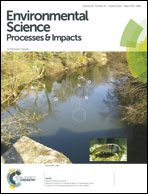Contaminants of emerging concern in fresh leachate from landfills in the conterminous United States†
Abstract
To better understand the composition of contaminants of emerging concern (CECs) in landfill leachate, fresh leachate from 19 landfills was sampled across the United States during 2011. The sampled network included 12 municipal and 7 private landfills with varying landfill waste compositions, geographic and climatic settings, ages of waste, waste loads, and leachate production. A total of 129 out of 202 CECs were detected during this study, including 62 prescription pharmaceuticals, 23 industrial chemicals, 18 nonprescription pharmaceuticals, 16 household chemicals, 6 steroid hormones, and 4 plant/animal sterols. CECs were detected in every leachate sample, with the total number of detected CECs in samples ranging from 6 to 82 (median = 31). Bisphenol A (BPA), cotinine, and N,N-diethyltoluamide (DEET) were the most frequently detected CECs, being found in 95% of the leachate samples, followed by lidocaine (89%) and camphor (84%). Other frequently detected CECs included benzophenone, naphthalene, and amphetamine, each detected in 79% of the leachate samples. CEC concentrations spanned six orders of magnitude, ranging from ng L−1 to mg L−1. Industrial and household chemicals were measured in the greatest concentrations, composing more than 82% of the total measured CEC concentrations. Maximum concentrations for three household and industrial chemicals, para-cresol (7 020 000 ng L−1), BPA (6 380 000 ng L−1), and phenol (1 550 000 ng L−1), were the largest measured, with these CECs composing 70% of the total measured CEC concentrations. Nonprescription pharmaceuticals represented 12%, plant/animal sterols 4%, prescription pharmaceuticals 1%, and steroid hormones <1% of the total measured CEC concentrations. Leachate from landfills in areas receiving greater amounts of precipitation had greater frequencies of CEC detections and concentrations in leachate than landfills receiving less precipitation.


 Please wait while we load your content...
Please wait while we load your content...